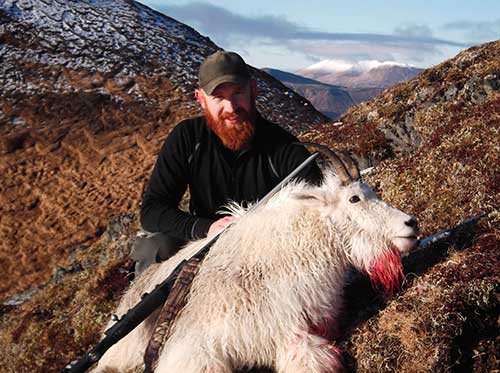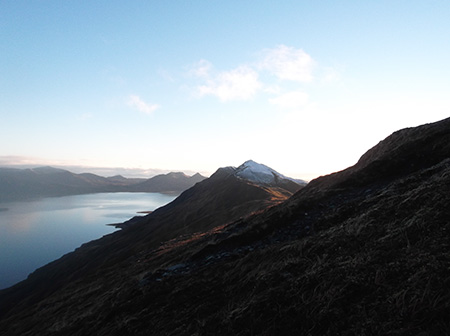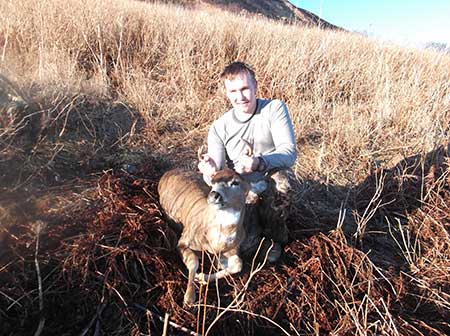Alaska Fish & Wildlife News
March 2015
A Far Walk From Here
Hunting mountain goats and deer on Kodiak Island

"In order to arrive at what you do not know/You must go by a way which is the way of ignorance.”
- T.S. Eliot, from East Coker
Getting There
I’m staring at a mountain. It’s early morning in late November, my mug of coffee billows in the shallow light. The snow of yesterday, which tops those spired peaks beyond, melted overnight. What remains is open ground; a canopy of rock and lichen, bent grasses and wind. I’m at sea level. The water in the bay is calm. Today we will climb. Again.
My body is willing to let me down. It’s day three and despite a break in the weather, what little resolve I can muster is quickly hushed by the muscles that cramped through the night, waking me like the cries of incessant infants, never quiet, never soothed.
“That’s beautiful,” I think to myself, visually wandering through the contours of the mountain beyond. I fail in my attempt to articulate further some sort of fresh way to advance beauty in words without collapsing on the broken cliché of men admiring mountains. I swill down what remains in my tarnished mug and leave poetics for another day.
I’m here to hunt. To stalk. To sit quietly and observe. To shoot and to kill. To take the life of some unknowing creature. Along with me is my good friend, C.D. One who I trust can handle himself and me as we share the experience in remote Alaska, far from television, Wal Mart, cell phones, computers and whatever else sedates an otherwise wild psyche.
I walk back into the cabin in which we are staying. The word cabin evokes an image of turned logs neatly joined, rustic décor, and snowshoes over the door. It’s not that kind of cabin. It’s more of a structure of necessity; it’s a warm and comfortable place to stay in an otherwise unpredictable landscape. And its owner has done well to outfit the place with only what is necessary. There are bunks, an oil-heating stove, cookware, a generator. Those who’ve come and gone have left items to rest here—salt, cans of green beans, freeze-dried foods, batteries, flashlights, sleeping bags and a few raunchy smut mags.
At noon we’re 2,000-feet up on the ridge. I’m staring at open water. Near black in contrast to the pale, alder-strewn granite peaks rising like tectonic fists in revolt. Some miles from here the world bends in on itself.
A pod of orcas breaks erratic the otherwise calm surface of water below. We pause to fathom their intent. Glass them with high-powered binoculars. The steep ridgeback is aglow with grasses and stones, weathered and punch-drunk against a stiff November breeze. We stumble on bear tracks, heavy indents in a stretch of ground lined out like disjointed ellipses. They lead higher into the sullen peaks beyond, where this bear sought a den for the self-induced coma of winter hibernation.
The Island is renowned for its bear population. The largest brown bears in the world live here. Two days before, as I walked along the beach, I encountered a large sow with cubs. She showed no interest in me and wandered off as if I were a mere nuisance, her small brood jostling quickly behind. Better she turn and give me the path back to the cabin than she hold ground. Bears know the danger of foreigners. Her beach anyway.
We follow the ridgeback tracks for a while in the opposite direction of where they lead. They are old tracks and we are not interested in an encounter. We follow these old trails because as we were glassing the area, I spotted a group of about 40 mountain goats flanking either side of a distant ridge. We estimated their distance at about two miles across the open country and opted to attempt an approach. We knew it would be challenging to get within range. Goats survive by being unavailable to any potential threat. They are built to climb. Broad chests, muscles wound tight as airline security, hooves like silk webs.
The goats we spotted were in a relatively easy location that we could access without climbing gear or wings. So we set out, pausing occasionally to monitor the demeanor of the herd. No doubt they could see us coming. But what were we to them? A mobile anomaly, a transient bi-pod with strong body odor. Luckily the wind favored our approach and while they could see us, they were unable to smell us.
When we were within 400 yards of the goats we dropped our heavy packs and belly-crawled on the soft terra. We had our eyes on a group of six goats browsing along an open section of the ridge. We’d pause. Glass. Crawl. Edge closer to the target, wanting to close the distance as much as possible. My preferred shooting distance is between 100 and 200 yards. Beyond that I’m throwing hail-mary passes to an oblivious receiver.
Our hunt occurred on the South end of the Island. Both C.D. and I had the RG480 hunting permit for Mountain Goat, and the Unit 8 Remainder hunting permit for deer.
Our intent was to hunt hard. Shoot a goat if we could, but more than likely pick up a couple deer. C.D. was, however, facing a challenge. Two days before the scope on his gun broke. The crosshairs simply fell apart. He was left with open sights, old school aiming.

The terrain was marked by small hills. Up. Then down. The target goats were on a slanting ridge much higher than the small mounds we maneuvered. As we crawled, we came up to the top of one mound and looking down we spotted five goats in the belly between this mound and the higher ridge. We were about 100 yards from the small herd. We stopped. Crawled back as to be out of sight. They didn’t know we were there. The target goats, however, were eyeing us the way children stare down an oncoming thunderstorm. Seemingly as intrigued by our form and movement as they were concerned and ready to head for cover.
One goat lay sleeping in the belly. I crawled up and put the scope on it. Chambered a round and took aim. I turned to C.D., who was taking aim at another goat and told him I was going to fire.
It’s a unique moment when readying the rifle to kill. I seldom am able to achieve a similar type of mental state. I can’t define the moment. Adrenaline and compassion. A certain mental clarity. The tentacle spread across the surface of skin without feeling pain or discomfort.
Hunters speak of the moment the trigger is pulled. How they don’t feel the kick of the rifle or hear the sound of the bullet firing. And it’s true. The senses fail. Or momentarily cease.
The goat’s body crumbled. Took the speeding lead and dropped dead instantly. Never woke. Those around began to move away, startled by the sound of the gun. I don’t know if C.D. attempted to fire. I turned to him and smiled. Used an expletive to convey my emotion. The ridge goats, now farther away, were still within range. I handed my rifle to C.D. He took aim and fired. Nothing happened. I never ejected the spent casing. He pulled the bolt back, ejected the shell, chambered another round, took aim and fired. It was a far shot. I believed I heard the telltale punch of bullet entering flesh. I had my eye on the goat he was aiming at. It didn’t react to the shot. Simply walked off out of sight.
He got up and walked over to where the goat he shot at was. Looking for blood. Hair. Signs of impact. Found nothing. Clean miss.
About an hour later we had my goat dressed out. Meat weighed heavy on our backs. It was getting late in the day and we had to get moving to make it back to the cabin before dark. We were about seven miles from where we began our day. Thirsty. Exhausted. Blood soaked. Grateful. Thank you, Lord. For this. For allowing us to experience the wonder of your creation in this way. We are humbled by your glory.
A Long Shot
I dreaded doing it again. The top of the ridge where I shot the goat the day before beckoned us back. Maybe the goats re-banded. Maybe they’d be there. Maybe we could shoot again. Maybe C.D. could harvest one, too. I wanted it to happen. So we loaded our packs heavy again with protein bars, water, knives and game bags. The morning opened up with calm resplendency. The irony of witnessing such beauty with a broken body. How indifferent the morning sun can be.
We headed out, following the same path we had each day prior. It is a well-worn path straight up the mountain. I told myself I’d take it slow. Not be pushed harder by the fact that C.D. is faster than me.
It took us a few hours to reach the peak. We stood and glassed the surrounding landscape, which by now was familiar. We spotted goats miles away, across an open valley. They were there the day before. Small bands glued to rock spires. I turned to glass the area where I shot my goat. Nothing but grass. Rock. They were gone. We walked toward the ridge anyway, hoping that maybe they were just out of sight, hidden in the belly between.
More miles. And nothing. We turned and headed back down. We’d choose an open spot along the side of the mountain to sit and glass for deer. We knew they were holding tight in thick cover. We’d seen deer each day. Mostly they were spooked from hiding and we caught them as they fled.
We found an area between ridges and dropped our packs. I took a higher view than C.D., who opted to stay lower and get a better view of the middle mountain. His strategy was rewarded. A short time in, as we each sat glassing, he backtracked up the ridgeline to meet me. “I’ve got a deer,” he whispered. He was quick to point to where it was. I had been glassing the same area as he and had simply scanned right over the obvious form of a buck deer standing in the thicket. We ranged the deer at 427 yards. He was using a spare rifle I brought along. A lesser caliber gun that is more accurate than a falcon. I told him it was sighted in at 100 yards. He said he was going to make an approach on the deer and slowly descended from our position. I glassed the deer. It would occasionally turn its head and watch us. Then go back to feeding.
He made his approach skillfully. Edging ever closer to the forked-horn buck. He stopped atop a small rock outcropping, ranged the deer again and positioned the rifle securely. I could tell he was quite a distance away. Maybe 300 yards.

The shot rang out. The thud of bullet entering flesh reached across the distance. The deer dropped. “You hit him!” I said. It wasn’t dead. The deer began to move. “Shoot him again!” I yelled. Another shot. Thud. The deer fell again, this time on its back. Legs up. Disappeared into the thick brush. We grabbed our gear and made our way over to the location. We searched. And searched. And searched. The body had been swallowed by mountainside fauna.
It took about a half hour to finally locate the deer. Seemed longer. I had to climb to a higher vantage point and direct C.D. to the general area where I saw the animal drop. He found blood first. Followed the stain. Grabbed the animal by the antlers and pulled it free from the brush. Pictures. Congratulations. 331 yard shot. Dress the animal. Load all the flesh and bone into packs. Leave only hide and entrails. Head back to the cabin. Eat. Sleep. Prepare for tomorrow.
The Placebo Effect
Odd what the ocean rejects. Coughs up on the land.
After descending from a high ridge through thick alders and rain we finally hit the black-stone beach. A cacophony of stones thin as wafers. Millions of perfectly formed flat stones ripe for skipping across the flat water. The hike down was dangerous. We were soaked. Coat pockets and boots full of water. We had to hike a few miles back to the cabin. It was late in the day. Hands and minds deformed by rain. One foot in front of the other.
Along shoreline we passed fish skulls, frayed rope, driftwood and jellyfish. Large blobs like masses of silicone rained down. We’d stop and prod the disfigured forms. Stab them with the blunt end of a walking staff. Tease their spaghetti-like tentacles from their slob underside. If we were to wrap ourselves in jellyfish, pick one up and hold it, the poison within would irritate our skin and cause pain. We talk about how a common antidote to poison is human urine. We laugh at the thought of someone peeing on an unfortunate victim of a jellyfish sting.
C.D. says that he’s heard this method of easing the pain of a jellyfish sting is ineffective. That it plays to the ignorance of the victim. Convinced that such a dramatic measure of applying human urine to jellyfish sting is in fact effective, the recipient will respond by believing the feeling subsides. The ignorance of pain beset by the willingness of the body to achieve relief. A sort of relative will, where the mind—convinced of change—rejects the disfigured thrum of an otherwise uncomfortable reality. He shared this anecdote on our first day out. And what he said became, for me, the idea that would push me forward in the days that followed. Beyond leg cramps and the thought of climbing higher. The tentacles of jellyfish. That pain is only as strong as I believe it to be.
Home
Three-quarters up the mountain again, slightly overcast. We stop to glass. Wind blowing across the mountainside cools our bodies. We talk. It’s been a great experience. Are we in need of more? No. Do you want to end the hunt a day early? Yes. Grab the satellite phone and call the air-taxi service.
Seeing different now as the endless peaks fade across the window with the slow rocking motion of the plane, I survey the valleys of dry blood across my hands. Bones ache. Muscles, too. For any trip beyond, it’s always a shame to have to return, knowing what is left behind. I turn my camera on and scroll through the pictures. The cabin. The mountain. The goat. C.D.’s deer. Jellyfish. A sum greater than the parts of the whole.
Back in Anchorage, our wives meet us at the airport. We load our gear in separate vehicles, make plans to process the meat. Shake hands. Then depart. Under the opacity of evening clouds, the pulse and voracity of the city seems to further define the antithetical clarity of midnight silence across a calm bay from which mountains rise. Hard to readjust to the attitude of taillights, pre-packaged groceries, indoor plumbing and the six o’clock news. It’s as if these small burdens veil an otherwise direct view of the magnitude of what lies beyond, where no ordinary mountains stand forever blind in the ocean of routine. And it’s only a matter of time before we go again, to a new unknown. But all the while, we’ll carry those mountains with us.
For more information about mountain goats, visit the Alaska Department of Fish and Game species profile page at: http://www.adfg.alaska.gov/index.cfm?adfg=goat.main
For more information on mountain goat hunting opportunities in Alaska, visit: http://www.adfg.alaska.gov/index.cfm?adfg=goathunting.main .
For information on hunting Sitka black-tail deer in Alaska, visit: http://www.adfg.alaska.gov/index.cfm?adfg=deerhunting.main .
Ryan Ragan is an information officer with the Sport Fish Division in Anchorage.
Subscribe to be notified about new issues
Receive a monthly notice about new issues and articles.
